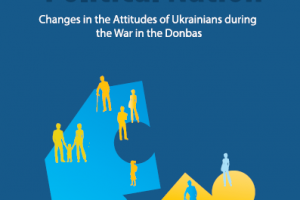Test of society’s maturity
 Vakhtang Kipiani, journalist
Vakhtang Kipiani, journalist
To say that elections held in Ukraine are civilized and European-style would be an exaggeration. But as the unforgettable Mikhail Gorbachev said “the process is in full swing”. The democratic anarchy in our elections ends on the day that the people express their will when campaign headquarters try to achieve their goal of exerting influence on the voting process. For instance, in the last days of 2009 the Internet was overloaded with statements on newly created websites appealing to the electorate “sell your vote or we’ll buy your vote!” Well informed experts say the demand for small and cheap “gratuities” that the organizers of vote rigging will offer uninformed citizens to “properly” fill out voting ballots has gone sky high at stores that sell photography products and accessories. Using such tricks the entire election sociology can easily be corrupted.
So, once again just as in previous years society’s attention has been riveted to exit polls. This has become a long-standing tradition. To be sure, over the last 11 years the Democratic Initiatives Foundation (DIF) has organized 11 (9 national and 2 regional) campaigns in which voters are polled upon exiting voting stations. This is as indispensable a component of national elections as a Christmas tree during the Christmas and New Year holidays.
Be that as it may, as is asserted in a well-known ad “not all yogurt is good for you”. By the same token, not all exit polls are complicit in electoral sociology. Here and there a one-time “syndicate of swindlers or fraudsters” is masked in exit polls whose objective is to cover up vote rigging at voting stations. Unfortunately, genuine sociologists often play such dishonest games. The incident on the night of the elections when the colleagues of the Exit Poll 2004 – Socis (M. Churilov) and Social Monitoring (O. Balakiryeva) – secretly altered their data in favor of Viktor Yanukovych and accused embassy representatives of forcing them to alter the results in favor of Viktor Yushchenko became a textbook example.
The most authoritative consortium that has extensive experienced in organizing exit polling at voting stations is the National Exit Poll. The project concept and implementation is the brainchild of DIF Director Ilko Kucheriv. The well-known sociologist Iryna Bekeshkina is invariably the project’s scientific manager. The Kyiv International Institute of Sociology (KIIS) headed by Prof. Volodymyr Paniotto has participated in conducting exit polls since 1999, while the Razumkov Centre for Political and Economic Studies has participated since 2004.
Below is the general list of election campaigns in which Ukrainians had the opportunity to compare official data of election commissions with the data of sociological centers that are independent of the government and election race contenders.
1. 1998 Parliamentary Elections. The first public announcement of the results of exit polls in Ukraine was aired live on the program Election Night on the 1+1 TV channel.
2. First round of the 1999 Presidential Election
3. Second round of the 1999 Presidential Election
4. 2002 Parliamentary Elections
5. 2004 Mayoral Elections in Mukacheve
6. First round of the 2004 Presidential Election
7. Second round of the 2004 Presidential Election
8. Third round of the 2004 Presidential Election
9. 2006 Parliamentary Elections
The results of the most recent polling upon exit from voting stations conducted under the aegis of the National Exit Poll compared to the official data released by the Central Election Commission serve as a good example.
Party | Final results of the Exit Poll 2007 | Data of the CEC |
4. Party of Regions |
35.3 |
34.37 |
8. Bloc of Yulia Tymoshenko (BYuT) |
31.5 |
30.71 |
14. Our Ukraine – People’s Self-defense |
13.5 |
14.15 |
13. Communist Party of Ukraine |
5.1 |
5.39 |
7. Bloc of Lytvyn |
3.8 |
3.96 |
6. Socialist Party of Ukraine |
2.5 |
2.86 |
12. Progressive Socialist Party of Ukraine |
1.5 |
1.32 |
16. Svoboda All-Ukrainian Union |
0.9 |
0.76 |
1. Communist Party of Ukraine (revamped) |
0.6 |
0.29 |
18. Green Party of Ukraine |
0.5 |
0.4 |
9. Lyudmyla Suprun Election Bloc – Ukrainian Regional Active |
0.3 |
0.34 |
5. Party of Free Democrats |
0.2 |
0.21 |
3. Ukrainian People’s Bloc |
0.2 |
0.12 |
19. Bloc of the Pensioner’s Party of Ukraine |
0.1 |
0.14 |
21. KUCHMA election bloc of political parties |
0.1 |
0.1 |
11. Agrarian Ukraine farmers’ bloc |
0.1 |
0.11 |
10. Christian Bloc |
0.1 |
0.1 |
2. Party for the National Economic Development of Ukraine |
0.1 |
0.14 |
15. All-Ukrainian Community Bloc |
0.0 |
0.05 |
20. All-Ukrainian party People’s Trust |
0.0 |
0.02 |
22. Did not vote for any party or election bloc |
2.9 |
2.73 |
23. Don’t recall |
0.3 | |
24. Number of incorrectly filled out ballots |
0.3 |
As we can see, the deviation between the data of the National Exit Poll of three years ago and the data of the CEC was minimal and within the bounds of sociological margin of error.
Today, DIF, KIIS and the Razumkov Centre are preparing for the conduct of widescale polling. I am convinced that the exit poll is a test of the absence of falsification of the election results. At the same time, it is a test of the maturity of civil society in Ukraine.
Admittedly, this time around certain campaign headquarters order their “own” exit polls without even naming those that will guarantee the fairness and objectiveness of election results by their reputation and professionalism. It is said that on January 17 a total of six polls will be conducted. And this is not a triumph of sociology, rather a consequence of the “jeans” psychology of leaders of the political class that in recent years have grown accustomed to paying off not only journalists and masters of show business, but also people with scientific regalia.
Be that as it may, they tend to forget that the authority that takes years to build up dissolves during live broadcasts throughout the night and hourly update of the vote count by the Central Election Commission…








